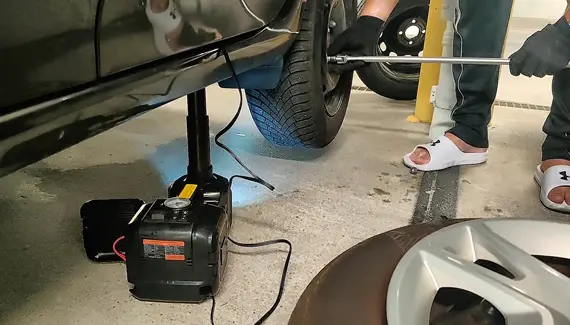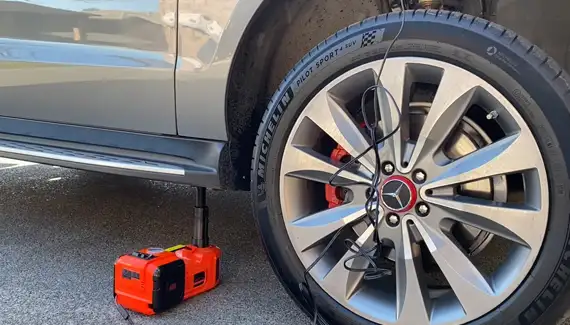Last Updated on April 12, 2023
The most common reason for jacking up an electric vehicle is to work on the tires, brakes, suspension, or electrical systems. Jacking up your electric car will give you the extra space and height necessary to make repairs. But can you jack up an electric car with a car jack?
It is certainly possible to jack up an electric vehicle using a car jack.
Most jacks are designed for gasoline-powered cars, typically much heavier for their large engines than electrical ones. Thus, using a car jack for an electric car should not be a problem. But before you jack up a car, you must ensure the jack is adequately rated for an electric car.
When you jack up your electric car, ensure the jack is placed on a solid, level lifting surface. The following information will give you a better understanding of using a car jack to lift an electric car.
How Can You Jack Up an Electric Car With a Car Jack?

Car jacks are handy tools if you need to access the underside of your electric car. Many think electric cars are challenging to work on because they do not have a traditional engine.
But jacking up an electric car is a relatively simple process, and here’s how to do it:
Step 01. Park Your Car on a Level Surface
You must park on a level surface when using a jack. After all, most traditional jacks can be used on any type of surface. But, the electric car jack is explicitly designed for level surfaces. This is because the jack needs to be able to make contact with both the ground and the car to work correctly.
If the car jack is not level, it will not be able to make good contact with either the ground or the car, which could lead to severe consequences. Also, the weight of the battery pack needs to be evenly distributed for the jack to work correctly.
If the car is not level, the jack will put too much pressure on one side of the battery pack, causing it to bend or break.
Step 02. Put Wheel Chocks Under the Tire
Wheel chocks are an essential safety precaution when jacking up an electric car. By placing them under the tires on the opposite side of the car from where it will be jacked up, you keep it from rolling or slipping off the jack.
Even if the surface is level, chocks can provide an extra measure of stability and keep the vehicle from moving unexpectedly. You may substitute bricks or cinder blocks if you do not have chocks. So, whenever you jack up a car, be sure to put wheel chocks in place for safety.
Step 03. Set the Car Parking Brake
You should also set the parking brake when using a floor jack (AKA trolley jack) to support your electric car. The parking brake will help to keep the car from rolling while the jack supports it. If the parking brake is not set, there is a risk that the car could roll off of the jack, causing serious injury.
Plus, setting the parking brake will ensure the car is not creeping forward or backward while being lifted. Thus, it is always best to set the parking brake whenever you use a floor jack.
Step 04. Place the Jack Under the Jack Point
Before you place the jack under the vehicle to jack up your electric car, you must identify the appropriate lifting point. On the underside of your vehicle, the lifting point may appear as a flat metal piece or a notch.
Once you have located the lifting point, position the jack beneath the jacking point and begin to lift the electric car. Remember to work carefully under lifted vehicles.
Step 05. Start Rising the Jack
Now slowly turn the handle clockwise until the car is lifted off the ground. Be careful not to over lift the vehicle. Over lifting can wreak havoc on the car or cause it to become unbalanced and fall off the jack. If you need to get under the car, stop raising the jack when there is enough room for you to slide underneath.
Be sure to stop turning the handle when the car is just high enough to insert a jack stand; if you continue turning, you may harm the car’s frame.
Step 06. Place Two Jack Stands for Extra Support
Any time you work on your car, you must take precautions to prevent injury and damage. One such safeguard is to use jack stands when lifting your car off the ground.
Two jack stands should be used for extra support while jacking up a car. The main reason is that it provides stability and prevents the vehicle from wobbling or falling off the jack.
Also, having two jack stands ensures that even if one fails, the other will be there to provide support. Plus, using two jack stands gives you peace of mind knowing that your car is safe and secure while working on it.
These simple steps will help you safely and efficiently jack up your car. Remember to always use caution when working under a lifted vehicle. If you doubt your ability to jack up your car, consult a professional mechanic safely.
Is it Possible to Jack Up an Electric Car With Any Car Jack?

Any car jack can lift electric cars, depending on their lifting capacity. Most people are unaware that electric cars should be jacked up according to their lifting area. If you don’t have the proper car jack or knowledge, jacking up an electric car may be dangerous and cause further damage to your vehicle.
The main reason for this is that the batteries in electric cars are located on the floor. This means that when you elevate an electric car, you are lifting the entire weight of the car off of the ground. Lack of experience jacking up cars can be a big problem.
You should also ensure you use the correct jack for your car. If you use the wrong jack, you could damage your vehicle or even injure yourself. So, if you’re thinking about jacking up an electric car, be sure to do your research and find out exactly what jack you need.
How Do I Know What Size Jack I Need for My Electric Car?

The size of the jack that is required for your electric car depends on the gross weight of your vehicle and the strength of the jack. The total gross weight is the car’s and cargo’s weight. The lifting capacity is the amount of weight the jack can safely lift.
You’ll need to do a little math to determine what size jack you need for your electric car. Multiply the total gross weight by 1.2. This will give you the minimum lifting capacity you’ll need. For example, if your car’s total gross weight is 4,000 pounds, you’ll need a jack with a lifting capacity of at least 4,800 pounds.
Now, divide the minimum lifting capacity by 2. This will give you the maximum safe load for each jack side. For example, if your car has a minimum lifting capacity of 4,800 pounds, each side of the jack should be able to lift no more than 2,400 pounds.
Check the manufacturer’s recommendations to see if there are any special instructions for your particular make and model of the electric car.
What Type of Jack Do I Need for Jacking Up an Electric Car?
If you need to jack up an electric car, you’ll need a hydraulic floor jack to support the vehicle’s weight. These floor jacks come in different sizes and capacities, so be sure to choose one that is rated for the weight of your car.
Many electric cars are relatively light, so a standard floor hydraulic jack should be sufficient. But you may need a heavy-duty jack if you have a heavier vehicle. In addition to the weight capacity, consider the lifting height of the jack.
Some jacks only lift a few inches off the ground, while others can raise the car several feet in the air. You’ll also want to ensure the jack is stable and won’t tip over when using it.
Are There Any Potential Risks of Jacking Up an Electric Car?

Just like any other car, there are certain risks associated with jacking up an electric car. For instance:
- If the car is not adequately supported, it could fall off the jack and cause severe deterioration or injury.
- When the jack comes into contact with any live electrical circuits, it could create a shock hazard.
- If the wrong tool is used or the battery is harmed, it could leak hazardous chemicals or even explode.
- The cables connecting the battery to the rest of the car could be destroyed if they are strained or pulled too tight.
Jacking an electric car could disrupt the electrical system and cause a fire. Yet, these risks can be minimized by taking proper precautions, such as using jack stands to support the car and ensuring the cables are not stretched too tight.
Are Scissor Jacks Any Good for Electric Vehicles?
Not all jacks are created equal. An electric scissor jack is typically smaller and more compact than a floor jack, making it easier to store in the trunk of a car. But can scissor jacks be used with electric vehicles?
The answer depends on a few aspects:
- You should consider the weight of your electric vehicle. A lightweight scissor jack may be sufficient for raising a small hatchback, but it likely won’t be able to support the weight of a large electric SUV or truck.
- Take into account the clearance between the ground and your vehicle’s undercarriage. If there’s not enough clearance for a scissor jack to fit underneath, you’ll need to opt for a different type of jack.
- It’s worth considering how often you’ll need to use the jack. If you only plan on using it occasionally, then a scissor jack may be a good option. But, if you anticipate needing to change tires regularly, you might want to invest in a more robust floor jack.
To determine if a scissor jack is the most suitable choice or not for your electric car, you should consider these considerations.
Safely and Easily Jack Up Your Electric Vehicle
Jacking up an electric vehicle with a car jack is not as difficult of a task as it may seem. You can accomplish this task safely and easily with the right equipment and know-how.
Just follow all the necessary steps discussed above, such as parking your car on level ground and setting the parking brake before beginning. Also, selecting the correct size and type of jack for your electric vehicle is vital to avoid any potential risks or damages while jacking up your vehicle.
With proper procedure and the right tools in hand, you’ll be able to safely lift your car off the ground without damaging it.
